

Robert K. Semans, Electronic Device Pioneers of Silicon Valley (1906–1939), 2002; oil on canvas, 9 x 18 ft.
Harold Hohbach, a patent attorney and real-estate developer whose mixed-use projects and whimsical art helped transform the area around Palo Alto’s California Avenue died in December 2017 at age 96. According to an obituary in the Palo Alto Online site, Hohbach was “Known for his dogged persistence, his irascible nature, his uncompromising style, and his deep appreciation for Silicon Valley's legacy of innovation.”1
His best-known art project is probably the classical female nude holding a washing machine fountain over her head in the public space outside Caffe Riace at 200 Sheridan Avenue. Somewhat less public is a large canvas painting depicting early San Francisco Bay Area technology pioneers that is currently on display in the adjacent office of engineering design firm Hohbach-Lewin at 260 Sheridan Avenue. Hohbach’s son Doug is a principal of the firm.
Hal Hohbach spent more than 40 years working as a patent attorney, developer, and investor, including serving on the board of Sutter Hill Ventures. His admiration for the persistence and contributions of inventors culminated in his commissioning of a modern-day version of Christian Schussele’s 1862 composite portrait of American Men of Progress, scientists and inventors who “had altered the course of contemporary civilization.” Currently in the National Portrait Gallery of the Smithsonian Institution, the work features 19 men, including Samuel Colt (fire arms), Elias Howe (sewing machine), and S. F. B. Morse (telegraph).2
Hohbach consulted with technology historian Donald F. Koijane of Menlo Park to identify the most significant pre–Silicon Valley era radio and electronics pioneers. In 1998 he commissioned San Jose portrait artist Robert K. Semans to paint a 9x18-foot, tryptic canvas portrait of 14 figures posed with examples of their equipment near the eastern arch of the Stanford University quadrangle. Lee de Forest holds his Audion vacuum tube. Charles “Doc” Herrold, founder of the radio station that became KCBS, speaks into a microphone. William Hewlett and David Packard demonstrate an HP200 audio oscillator to their mentor Frederick Terman. All had some association with the university and/or worked in the area between 1906 and 1939.
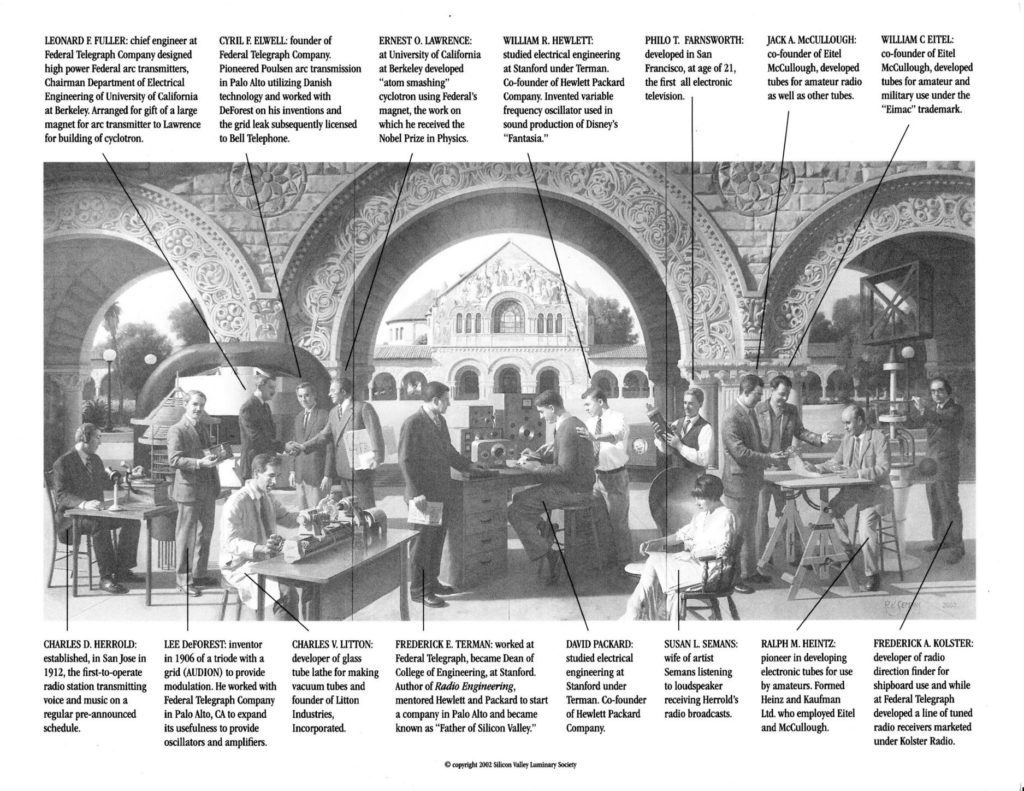
Key to pioneers included in Semans’s composite portrait.
Semans photographed representative groups of people at the site and used Adobe Photoshop to help determine the optimum placement and scale of the figures in the composition.3 He did add one lone woman to the group; his wife Susan, in a white dress, is seated in the foreground listening to music over a loudspeaker. He completed the work in 2002. Hohbach introduced the painting to the public in Palo Alto, under the auspices of his nonprofit Silicon Valley Luminary Society, in 2003.
I first became aware of Hal’s mission to ensure “the legacy of our community’s considerable scientific contribution to the world” through artwork commissioned by his Luminary Society in 2008. As semiconductor curator at the Computer History Museum, he sent me a fax requesting a a photograph of a diffusion furnace used in the manufacture of silicon wafers. On responding, I learned that he had commissioned artist Terry Guyer to produce a set of six 6 x 9-foot composite portraits of more recent Silicon Valley inventors.
At that point Guyer had already completed two works: Post WWII Inventors—Five Inventors and Scientists—Five Inventors. The diffusion furnace image was required as background for a new picture to be titled Semiconductors: Five Inventors, featuring William Shockley, Robert Noyce, Jean Hoerni, Gordon Moore, and Ted Hoff. These three new works were unveiled at a reception in Guyer’s Menlo Park studio in 2009.
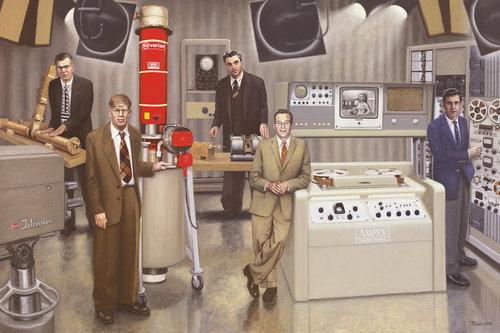
Terry Guyer, Post WWII Inventors—Five Inventors; oil on linen, 72 x 108 in. Left to right: William W. Hansen (raveling wave tube); Russell H. Varian (klystron); Felix Bloch (nuclear magnetic resonance imaging); Charles P. Ginsberg (video tape recorder); and Ray Dolby (noise reduction system).

Terry Guyer, Scientists—Five Inventors; oil on linen, 72 x 108 in. Left to right: Glenn T. Seaborg (plutonium); Robert Oppenheimer (atom bomb); Edward Teller (hydrogen bomb); Charles H. Townes (coinventor laser); and Arthur Schawlow (coinventor laser).
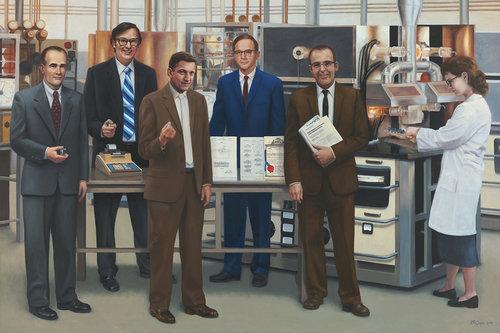
Terry Guyer, Semiconductors—Five Inventors; oil on linen, 72 x 108 in. Left to right: William Shockley (coinventor transistor); Marcian E. “Ted” Hoff Jr. (microprocessor); Robert N. Noyce (integrated circuit); Jean Hoerni (planar technology); Gordon Moore (Moore’s Law); and furnace operator unknown.
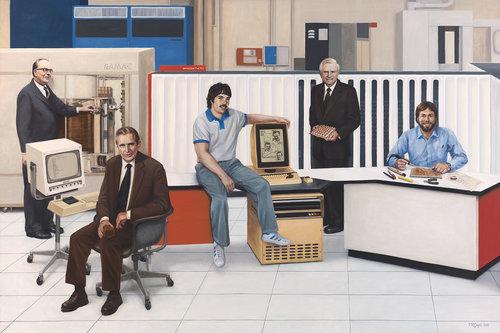
Terry Guyer, Computers—Five Inventors; oil on linen, 72 x 108 in. Left to right: Reynold Johnson (magnetic disc storage); Douglas Engelbart (interactive computing and mouse); Alan C. Kay (with GUI computer interface and Alto computer at PARC); Gene Amdahl (air-cooled mainframe computer); and Steve Wozniak (personal computer).
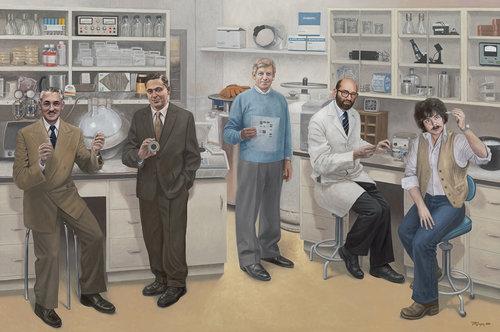
Terry Guyer, Biotechnology—Five Inventors; oil on linen, 72 x 108 in. Left to right: Alejandro Zaffaroni (drug delivery system); Carl Djerassi (birth control pill); William J. Rutter (Hepatitis B vaccine); Stanley N. Cohen (recombinant DNA); and Herbert W. Boyer (recombinant DNA).
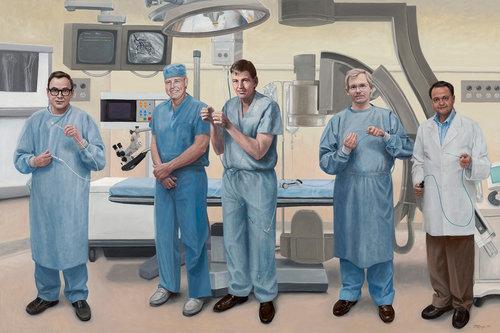
Terry Guyer, Medical Devices—Five Inventors; oil on linen, 72 x 108 in. Left to right: Thomas S. Fogarty (embolectomy balloon catheters); Rodney Perkins (LaserScope); John Simpson (angioplasty balloon slidaby mounted on guidewire); Paul Yock (rapid exchange angioplasty catheter); and Mir A. Imran (ablation catheter).
In 2017 Hohbach commissioned two more topics in the inventor series on Computer Networking and Internet Connectivity and Internet Commerce Pioneers. Following the death of his patron in December 2017, Holbach’s family agreed to support Guyer’s completion of the final two portraits. He finished them in May 2018.
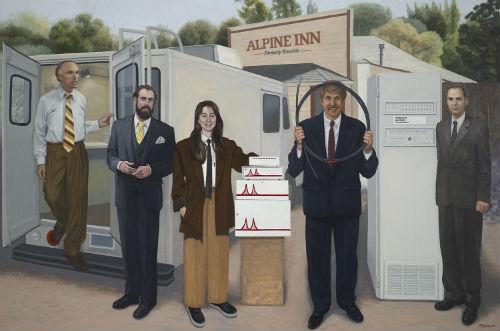
Terry Guyer, Computer Networking and Internet Connectivity Pioneers of Silicon Valley—Five Inventors; oil on linen, 72 x 108 in. Left to right: Don Nielson, Vint Cerf, Sandy Lerner, Robert Metcalfe, and Larry Roberts.
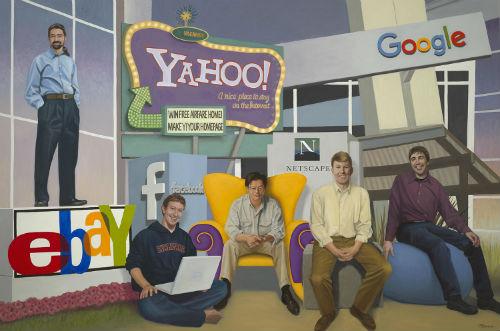
Terry Guyer, Internet Commerce Pioneers of Silicon Valley—Five Inventors; oil on linen, 72 x 108 in. Left to right: Pierre Omidyar, Mark Zuckerberg, Jerry Yang, Marc Andreessen, and Larry Page.
Before he passed, Hohbach made a bequest to Stanford University to expand its presentation of Silicon Valley technology artifacts in the Green Library on campus.4 All nine of the Luminary series of paintings will be added to the Stanford collection. It is anticipated that selected works will be displayed on a rotating basis in the remodeled space. No date for completion of the expansion is currently available.